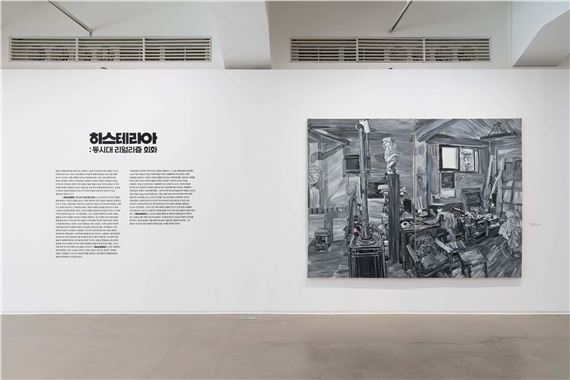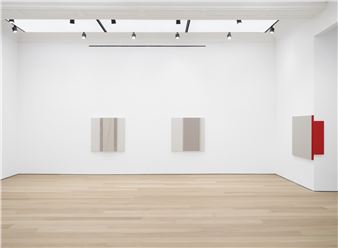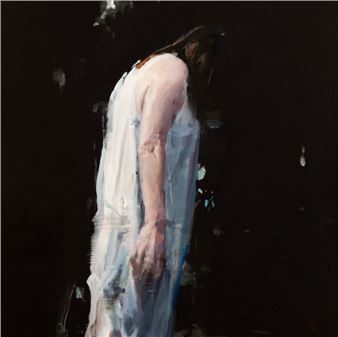Hysteria: Contemporary Realism Painting
Painting is a journey of filling in gaps with forms. To a painter, this desire is a natural impulse rooted in human origins and a mysterious drive that propels the creation and development of artworks. The task of transferring an observed subject onto a blank piece of paper, canvas, or wall inevitably involves the problem of representation. Even after contemporary art became interested in the negation or impossibility of representation rather than representation itself, certain forms of painting still strive to capture truth and reality, operating on the belief that an artwork and its subject, the artist and the world, are connected through visual truths. How is this effort evolving in the present day? How can it lead to an artist’s unique perception and way of expression?
The exhibition Hysteria: Contemporary Realism Painting delves into the “realism” of painting, particularly in the context of Korean art history, through the works of thirteen contemporary painters. The realism introduced in this exhibition is a mode of recognizing and presenting the world established by artists, under objective and empirical observation. Realism Painting seeks to equate the representation and the represented while recognizing the events and objects that constitute reality as flat. More than that, Realism Painting relies on figuration to approach its subjects as beings under dynamic force or in a tightly-knit network of senses. At a time when contemporary painting emphasizes flatness and reduction of nature to the point-line-plane postulate, the above approach connects to various efforts of renewing the basis of figuration while exploring the potential of painting outside the binary of abstraction versus historical realism. In Korea, painting has been relatively suppressed in the development of its unique local art history, especially as it is a medium based on the fundamental motive of drawing. Artists such as Choi Gene Uk, Yeesookyung, Chung Suejin, and Roh Choonghyun stood outside mainstream realism as a social expression and participation and explored the “hysterical” way that painting reacts to the world, as if in a nervous reaction. These artists’ practices reveal not only today’s reality but also the challenges that painting faces as a medium in the new world of media and images, as well as each artist’s unique approach to those problems and experimentations. Hysteria: Contemporary Realism Painting examines how artists such as Noh Sangho, Son Hyunseon, Lee Jaeseok, Lim Nosik, Jung Soojung, Ham Sungju, Kim Minhee, Cho Hyori, and Kim Hyewon (who are often considered to belong to the same family as the above group) adopt social and cultural changes of the 2020s as materials for their paintings.
“Realism is a dangerous monster that devours everything,” claims the realism-devoted novelist Henry James. This quote reveals the difficulty of retrieving Realism from the library shelf of history and examining it anew. Starting from the 1990s, identified as the rupture of ideology and economical borders, the advancement of the physical foundation of reality has accelerated at a speed too difficult for the advancement of art to catch up with. For a while, Realism was thought to be at a dead end in a world continuing like a never-ending playlist, robbed of the “hard shell” of reality—all senses of, say, challenges to overcome, legacy, time, and status. Meanwhile, Painting as a contemporary art form had exhausted its radicality through imagining its own endgame, the zombie formalism controversy, and the exploration of new statuses as complex supports or quasi-screens. And in this context, Realism was regarded as obsolete (too historical and therefore outmoded) or, in another sense, anachronistic (too ahistorical hence representing only subjectivity). However, with the recent rise of materialism studies, painting, specifically figuration, is resurfacing as a meaningful subject of examination among many contentious theories. Hysteria: Contemporary Realism Painting uncovers values of contemporary painting in the newly recognized context, perhaps described as “expanded Realism,” and explores its visuality relevant to today’s world. The Ilmin Museum of Art aspires to reexamine institutionalized Realism Art through this exhibition and view it as a chance to revisit, and transform, the discourse that has not been sufficiently contemplated before.

Recommended for you
Painting is a journey of filling in gaps with forms. To a painter, this desire is a natural impulse rooted in human origins and a mysterious drive that propels the creation and development of artworks. The task of transferring an observed subject onto a blank piece of paper, canvas, or wall inevitably involves the problem of representation. Even after contemporary art became interested in the negation or impossibility of representation rather than representation itself, certain forms of painting still strive to capture truth and reality, operating on the belief that an artwork and its subject, the artist and the world, are connected through visual truths. How is this effort evolving in the present day? How can it lead to an artist’s unique perception and way of expression?
The exhibition Hysteria: Contemporary Realism Painting delves into the “realism” of painting, particularly in the context of Korean art history, through the works of thirteen contemporary painters. The realism introduced in this exhibition is a mode of recognizing and presenting the world established by artists, under objective and empirical observation. Realism Painting seeks to equate the representation and the represented while recognizing the events and objects that constitute reality as flat. More than that, Realism Painting relies on figuration to approach its subjects as beings under dynamic force or in a tightly-knit network of senses. At a time when contemporary painting emphasizes flatness and reduction of nature to the point-line-plane postulate, the above approach connects to various efforts of renewing the basis of figuration while exploring the potential of painting outside the binary of abstraction versus historical realism. In Korea, painting has been relatively suppressed in the development of its unique local art history, especially as it is a medium based on the fundamental motive of drawing. Artists such as Choi Gene Uk, Yeesookyung, Chung Suejin, and Roh Choonghyun stood outside mainstream realism as a social expression and participation and explored the “hysterical” way that painting reacts to the world, as if in a nervous reaction. These artists’ practices reveal not only today’s reality but also the challenges that painting faces as a medium in the new world of media and images, as well as each artist’s unique approach to those problems and experimentations. Hysteria: Contemporary Realism Painting examines how artists such as Noh Sangho, Son Hyunseon, Lee Jaeseok, Lim Nosik, Jung Soojung, Ham Sungju, Kim Minhee, Cho Hyori, and Kim Hyewon (who are often considered to belong to the same family as the above group) adopt social and cultural changes of the 2020s as materials for their paintings.
“Realism is a dangerous monster that devours everything,” claims the realism-devoted novelist Henry James. This quote reveals the difficulty of retrieving Realism from the library shelf of history and examining it anew. Starting from the 1990s, identified as the rupture of ideology and economical borders, the advancement of the physical foundation of reality has accelerated at a speed too difficult for the advancement of art to catch up with. For a while, Realism was thought to be at a dead end in a world continuing like a never-ending playlist, robbed of the “hard shell” of reality—all senses of, say, challenges to overcome, legacy, time, and status. Meanwhile, Painting as a contemporary art form had exhausted its radicality through imagining its own endgame, the zombie formalism controversy, and the exploration of new statuses as complex supports or quasi-screens. And in this context, Realism was regarded as obsolete (too historical and therefore outmoded) or, in another sense, anachronistic (too ahistorical hence representing only subjectivity). However, with the recent rise of materialism studies, painting, specifically figuration, is resurfacing as a meaningful subject of examination among many contentious theories. Hysteria: Contemporary Realism Painting uncovers values of contemporary painting in the newly recognized context, perhaps described as “expanded Realism,” and explores its visuality relevant to today’s world. The Ilmin Museum of Art aspires to reexamine institutionalized Realism Art through this exhibition and view it as a chance to revisit, and transform, the discourse that has not been sufficiently contemplated before.
Contact details


 ARTISTS
ARTISTS












